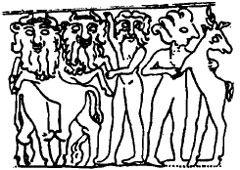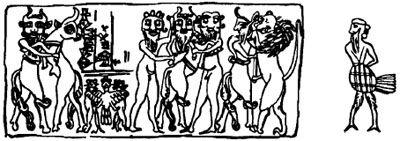The 12th Planet (54 page)
Authors: Zecharia Sitchin
Tags: #Non-Fiction, #Gnostic Dementia, #Fringe Science, #Retail, #Archaeology, #Ancient Aliens, #History

When Mankind was created,
They knew not the eating of bread,
Knew not the dressing in garments;
Ate plants with their mouth like sheep;
Drank water from a ditch.
Such an animal-like "human" being is also described in the "Epic of Gilgamesh." That text tells what Enkidu, the one "born on the steppes," was like before he became civilized:
Shaggy with hair is his whole body,
he is endowed with head-hair like a woman....
He knows neither people nor land;
Garbed he is like one of the green fields;
With gazelles he feeds on grass;
With the wild beasts he jostles
at the watering place;
With the teeming creatures in the water
his heart delights.
Not only does the Akkadian text describe an animal-like man; it also describes an encounter with such a being:
Now a hunter, one who traps,
faced him at the watering place.
When the hunter saw him,
his face became motionless....
His heart was disturbed, overclouded his face,
for woe had entered his belly.
There was more to it than mere fear after the hunter beheld "the savage," this "barbarous fellow from the depths of the steppe"; for this "savage" also interfered with the hunter's pursuits:
He filled the pits that I had dug,
he tore up my traps which I had set;
the beasts and creatures of the steppe
he has made slip through my hands.
We can ask for no better description of an ape-man: hairy, shaggy, a roaming nomad who "knows neither people nor land," garbed in leaves, "like one of the green fields," feeding on grass, and living among the animals. Yet he is not without substantial intelligence, for he knows how to tear up the traps and fill up the pits dug to catch the animals. In other words, he protected his animal friends from-being caught by the alien hunters. Many cylinder seals have been found that depict this shaggy ape-man among his animal friends. (Fig. 149)

Fig. 149
Then, faced with the need for manpower, resolved to obtain a Primitive Worker, the Nefilim saw a ready-made solution: to domesticate a suitable animal.
The "animal" was available—but
Homo erectus
posed a problem. On the one hand, he was too intelligent and wild to become simply a docile beast of work. On the other hand, he was not really suited to the task. His physique had to be changed—he had to be able to grasp and use the tools of the Nefilim, walk and bend like them so that he could replace the gods in the fields and in the mines. He had to have better "brains"—not like those of the gods but enough to understand speech and commands and the tasks allotted to him. He needed enough cleverness and understanding to be an obedient and useful
amelu
—a serf.
If, as the ancient evidence and modern science seem to confirm, life on Earth germinated from life on the Twelfth Planet, then evolution on Earth should have proceeded as it had on the Twelfth Planet. Undoubtedly there were mutations, variations, accelerations, and retardations caused by different local conditions; but the same genetic codes, the same "chemistry of life" found in all living plants and animals on Earth would also have guided the development of life forms on Earth in the same general direction as on the Twelfth Planet.
Observing the various forms of life on Earth, the Nefilim and their chief scientist, Ea, needed little time to realize what had happened: During the celestial collision, their planet had seeded Earth with its life. Therefore, the being that was available was really akin to the Nefilim—though in a less evolved form.
A gradual process of domestication through generations of breeding and selection would not do. What was needed was a quick process, one that would permit "mass production" of the new workers. So the problem was posed to Ea; who saw the answer at once: to "imprint" the image of the gods on the being that already existed.
The process that Ea recommended in order to achieve a quick evolutionary advancement of
Homo erectus
was, we believe,
genetic manipulation.
We now know that the complex biological process whereby a living organism reproduces itself, creating progeny that resemble their parents, is made possible by the genetic code. All living organisms—a threadworm, a fern tree, or Man—contain in their cells chromosomes, minute rodlike bodies within each cell that hold the complete hereditary instructions for that particular organism. As the male cell (pollen, sperm) fertilizes the female cell, the two sets of chromosomes combine and then divide to form new cells that hold the complete hereditary characteristics of their parent cells.
Artificial insemination, even of a female human egg, is now possible. The real challenge lies in cross-fertilization between different families within the same species, and even between different species. Modern science has come a long way from the development of the first hybrid corns, or the mating of Alaskan dogs with wolves, or the "creation" of the mule (the artificial mating of a mare and a donkey), to the ability to manipulate Man's own reproduction.
A process called cloning (from the Greek word
klon
—"twig") applies to animals the same principle as that of taking a cutting from a plant to reproduce hundreds of similar plants. The technique as applied to animals was first demonstrated in England, where Dr. John Gordon replaced the nucleus of a fertilized frog's egg with the nuclear material from another cell of the same frog. The successful formation of normal tadpoles demonstrated that the egg proceeds to develop and subdivide and create progeny no matter where it obtains the correct set of matching chromosomes.
Experiments at the Institute of Society, Ethics and Life Sciences at Hastings-on-Hudson, New York, have shown that techniques already exist for cloning human beings. It is now possible to take the nuclear material of any human cell (not necessarily from the sex organs) and, by introducing its twenty-three sets of complete chromosomes into the female ovum, lead to the conception and birth of a "predetermined" individual. In normal conception, "father" and "mother" chromosome sets merge and then must split to remain at twenty-three chromosome pairs, leading to chance combinations. But in cloning the offspring is an exact replica of the source of the unsplit set of chromosomes. We already possess, according to Dr. W. Gaylin of the Institute, the "awful knowledge to make exact copies of human beings"—a limitless number of Hitlers or Mozarts or Einsteins (if we had preserved their cell nuclei).
But the art of genetic engineering is not limited to one process. Researchers in many countries have perfected a process called "cell fusion," making it possible to fuse cells rather than combine chromosomes within a single cell. As a result of such a process, cells from different sources can be fused into one "super cell," holding within itself two nuclei and a double set of the paired chromosomes. When this cell splits, the mixture of nuclei and chromosomes may split in a pattern different from that of each cell before the fusion. The result can be two new cells, each genetically complete, but each with a brand-new set of genetic codes, completely garbled as far as the ancestor cells were concerned.
This means that cells from hitherto incompatible living organisms—say, that of a chicken and that of a mouse-can be fused to form new cells with brand-new genetic mixes that produce new animals that are neither chickens nor mice as we know them. Further refined, the process can also permit us to
select
which traits of one life form shall be imparted to the combined or "fused" cell.
This has led to the development of the wide field of "genetic transplant." It is now possible to pick up from certain bacteria a single specific gene and introduce that gene into an animal or human cell, giving the offspring an added characteristic.
•
We should assume that the Nefilim—being capable of space travel 450,000 years ago—were also equally advanced, compared to us today, in the field of life sciences. We should also assume that they were aware of the various alternatives by which two preselected sets of chromosomes could be combined to obtain a predetermined genetic result; and that whether the process was akin to cloning, cell fusion, genetic transplant, or methods as yet unknown to us, they knew these processes and could carry them out, not only in the laboratory flask but also with living organisms.
We find a reference to such a mixing of two life-sources in the ancient texts. According to Berossus, the deity Belus ("lord")—also called Deus ("god")—brought forth various "hideous Beings, which were produced of a two-fold principle."
Men appeared with two wings, some with four and two faces. They had one body but two heads, the one of a man, the other of a woman. They were likewise in their several organs both male and female.
Other human figures were to be seen with the legs and horns of goats. Some had horses' feet; others had the limbs of a horse behind, but in front were fashioned like men, resembling hippocentaurs. Bulls likewise bred there with the heads of men; and dogs with fourfold bodies, and the tails of fishes. Also horses with the heads of dogs; men too and other animals with the heads and bodies of horses and the tails of fishes. In short, there were creatures with the limbs of every species of animals....
Of all these were preserved delineations in the temple of Belus at Babylon.
•
The tale's baffling details may hold an important truth. It is quite conceivable that before resorting to the creation of a being in their own image, the Nefilim attempted to come up with a "manufactured servant" by experimenting with other alternatives: the creation of a hybrid ape-man-animal. Some of these artificial creatures may have survived for a while but were certainly unable to reproduce. The enigmatic bull-men and lion-men (sphinxes) that adorned temple sites in the ancient Near East may not have been just figments of an artist's imagination but actual creatures that came out of the biological laboratories of the Nefilim—unsuccessful experiments commemorated in art and by statues. (Fig. 150)

